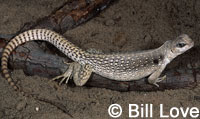In a past blog I mentioned one of my first pet lizards, Iguanadon, who was a desert iguana. I bought Iguanodon at a pet store in Topanga, Calif., i
In a past blog I mentioned one of my first pet lizards, Iguanadon, who was a desert iguana. I bought Iguanodon at a pet store in Topanga, Calif., in 1970. Back then all types of reptiles were available for purchase, including many different varieties of baby turtles. Various regulations were later imposed, of course, to help ease the pressures on wild populations and for other reasons. But back in those days a huge variety of animals were available for sale, and the first place I ever saw a desert iguana in the flesh was in a pet store in the Topanga Plaza Mall.
Up to that point I had only ever kept anoles. Confronted with a living desert iguana I was tingling with excitement. The word I would use to describe a desert iguana is “elegant.” Sure, Dipsosaurus dorsalis does not sport any of the impressive spines (just a slightly enlarged row of scales along the spine) or the dewlap of a mature Iguana iguana. But to me, the maroon and white coloration, small head and granular scales make for one very attractive lizard, and the desert iguana holds itself up proudly.
In the U.S., wild desert iguanas can be found in the Mojave and Colorado deserts (California, Nevada and Arizona). This lizard likes heat, and plenty of it. When other lizards may be seeking shelter in shady areas, the desert iguana will remain out basking, even in temperatures near 115 degrees Fahrenheit. Though not listed as endangered, it is listed by U.S. Fish and Wildlife as a “Species of Concern,” meaning it could be afforded federal protection someday.
As I said, I was excited at seeing a desert iguana, and my parents were kind enough to indulge me and buy it for me. I then proceeded to keep Iguanodon (yes, of course I liked dinosaurs, too; hence the name) in a wholly inappropriate manner: in a small, plastic terrarium with not enough heat. I did take him outside frequently, though, so he could bask in direct sunlight. He (or she, I have no idea) even made a move to Michigan with us. I remember carrying the terrarium on board the plane and getting interesting reactions from fellow passengers and flight attendants. We only lived in Michigan for about six months, so Iguanodon also got a return flight out of the experience.
I don’t remember now how long I had Iguanodon, but I’m sure he passed on too soon, as many of my first reptiles probably did (hatchling red-eared sliders, especially). But he made a huge impression on me, and opened my eyes to the many different possibilities that were available, animal-wise, within the hobby.
Many years later I was visiting Joshua Tree National Monument and saw my first desert iguanas in the wild. That was a huge thrill. I briefly entertained the notion of trying to capture one, but those suckers were lightning-fast. They would reach speeds that permitted them to run on their hind legs. Those wild desert iguanas made my memories of Iguanodon somewhat melancholy. Compared to those bright white, robust wild iguanas, Iguanodon, in both appearance and demeanor, was a shade of what he could have been.
That afternoon watching the desert iguanas was a special one (I did also come across a hatchling desert tortoise, so I was able to catch something). Occasionally captive-bred desert iguanas are offered for sale, though I never kept this species again. They need a lot of room and for now I want my memories of them to be those wild lizards running free. But if you have the facilities to care for a desert iguana, see if you, too, don’t find this beautiful lizard the most elegant you’ll ever find in a U.S. desert.



